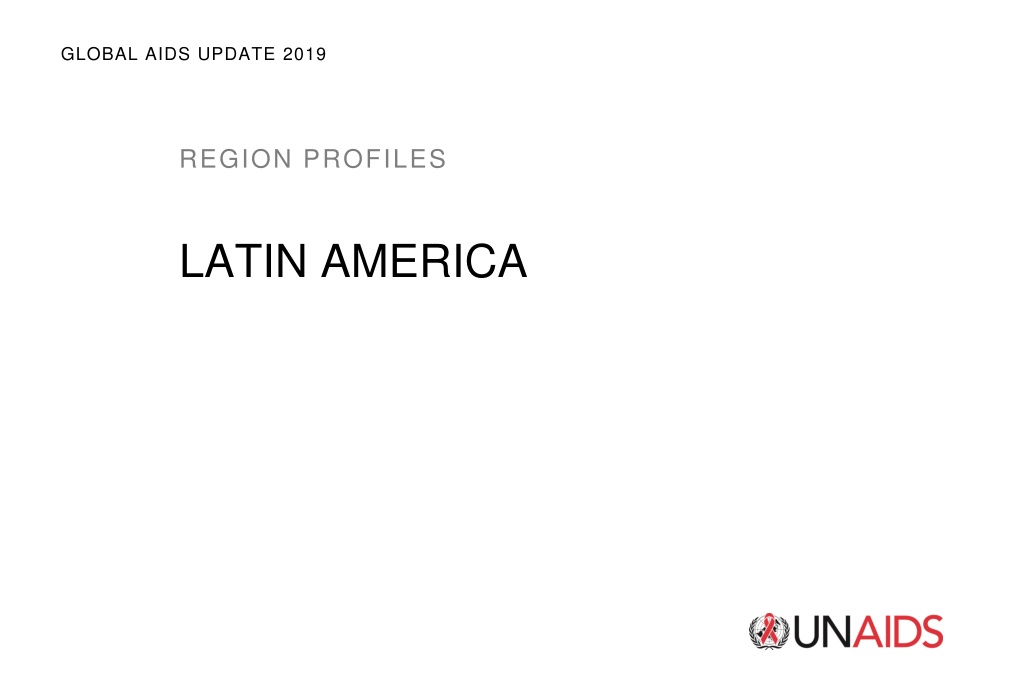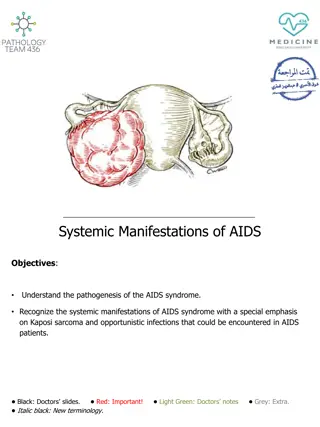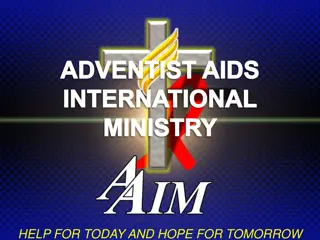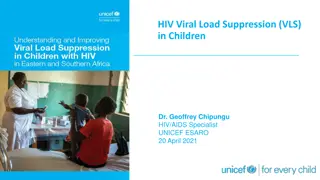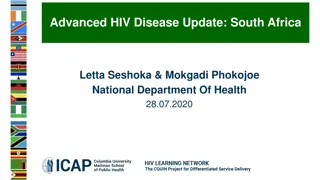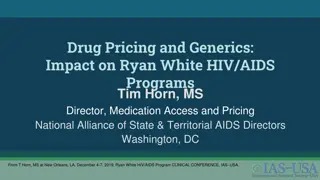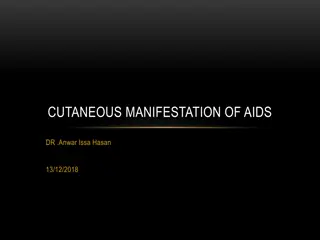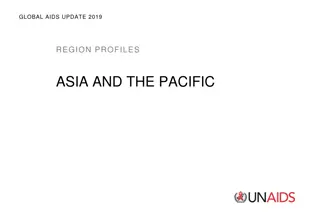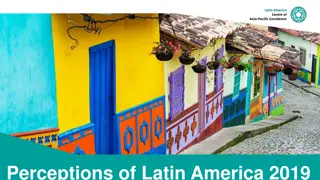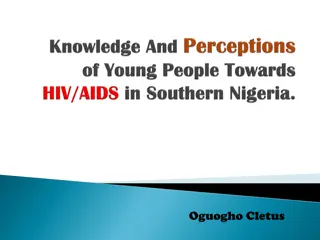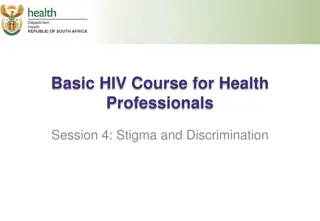HIV/AIDS Update in Latin America: Trends and Key Findings
This update provides insights into the HIV/AIDS situation in Latin America from 2000 to 2018, covering aspects such as new infections, AIDS-related deaths, incidence-prevalence ratio, and key population demographics. The data reflects changes in policies, prevalence among key populations like sex workers and drug users, and percentage changes in new infections by country. Key findings highlight progress and challenges faced in combating HIV/AIDS in the region.
Download Presentation

Please find below an Image/Link to download the presentation.
The content on the website is provided AS IS for your information and personal use only. It may not be sold, licensed, or shared on other websites without obtaining consent from the author. Download presentation by click this link. If you encounter any issues during the download, it is possible that the publisher has removed the file from their server.
E N D
Presentation Transcript
GLOBAL AIDS UPDATE 2019 REGION PROFILES LATIN AMERICA
Self-testing in national policies, Latin America, 2018 Yes No Source: 2019 Global AIDS Monitoring.
Number of new HIV infections and AIDS-related deaths, and incidence-prevalence ratio Latin America, 2000 2018 New HIV infections AIDS-related deaths Incidence-prevalence ratio 16 160 000 70 000 Percentage change in new HIV infections since 2010 +7% Percentage change in AIDS- related deaths since 2010 -14% 2018 Number of AIDS-related deaths Number of new HIV infections 14 140 000 60 000 Incidence- prevalence Incidence-prevalence ratio 12 120 000 50 000 ratio 10 100 000 40 000 5.4% [4.1 6.8%] 8 80 000 30 000 6 60 000 20 000 4 40 000 3 2 10 000 20 000 0 0 0 2000 2010 2018 2000 2010 2018 2000 2005 2010 2015 2018 New HIV infections AIDS-related deaths Incidence-prevalence ratio Target value Source: UNAIDS 2019 estimates.
Percentage change in new HIV infections, by country, Latin America, 2010 2018 40 34 30 22 21 21 20 9 10 7 6 2 0 Per cent 0 -6 -10 -8 -11 -12 -20 -22 -30 -29 -40 -50 -48 -60 Paraguay Uruguay Mexico Chile Colombia Honduras Bolivia (Plurinational State of) Nicaragua Argentina Peru Brazil Panama El Salvador Guatemala Costa Rica Ecuador Source: UNAIDS 2019 estimates.
HIV prevalence among key populations Distribution of new HIV infections (aged 15 49 years), by population group Latin America, 2014 2018 Latin America, 2018 40 Sex workers 3% People who inject drugs 3% 35 30 25 22.2 Percent Remaining population 35% 20 Gay men and other men who have sex with men 40% 15 12.6 10 3.6 5 0.7 1.2 0 Clients of sex workers and sex partners of other key populations 15% Sex workers, n = 13 Gay men and other men who have sex with men, n = 15 Transgenderwomen 4% People who inject drugs, n = 2 Transgender people, n = 3 Prisoners, n = 13 Source: UNAIDS Global AIDS Monitoring, 2014 2018. Source: UNAIDS special analysis, 2019.
Estimated size of key populations, Latin America, 2018 Country National adult population (15+) Sex workers Sex workers as per cent of adult population (15+) Gay men and other men who have sex with men Gay men and other men who have sex with men as per cent of adult population (15+) People who inject drugs People who inject drugs as per cent of adult population (15+) Transgender people Transgender people as per cent of adult population (15+) Prisoners Prisoners as per cent of adult population (15+) Bolivia (Plurinational State of) 7 711 000 Chile 14 538 000 42 000 0.29 Costa Rica 3 893 000 100 <0.1 Mexico 96 429 000 240 000 0.25 1 200 000 1.23 120 000 0.12 200 000 0.21 Panama 3 033 000 Peru 23 731 000 Uruguay 2 743 000 6900 0.25 25 000 0.92 1600 0.06 Venezuela 23 545 000 15 000 0.06 National population size estimate Local population size estimate Insufficient data No data The regions for which the local population size estimate refers are as follows: Costa Rica: Gran rea Metropolitana Panama: Azuero, Bocas del Toro, Chiriqu , Cocl , Comarca Ng be-Bugl , Panam Centro, Panam Este, Panam Oeste, Panam Norte and Veraguas Source: Global AIDS Monitoring, 2018; United Nations, Department of Economic and Social Affairs, Population Division. World population prospects: the 2017 revision. 2018 (custom data acquired via website).
HIV testing and treatment cascade, Latin America, 2018 3 Gap to reaching the first 90: 199 000 2 Gap to reaching the first and second 90s: 362 000 Number of people living with HIV (million) Gap to reaching all three 90s: 340 000 80% [62 >95%] 1 62% [43 78%] 55% [42 69%] 0 People living with HIV who know their status People living with HIV on treatment People living with HIV who are virally suppressed Source: UNAIDS special analysis, 2019; see annex on methods for more details.
909090 country scorecard: Latin America, 2018 First 90: percentage of people living with HIV who know their HIV status Second 90: percentage of people living with HIV who know their status and who are on treatment Third 90: percentage of people living with HIV on treatment who have suppressed viral loads Viral load suppression: percentage of people living with HIV who are virally suppressed All ages Women (15 years and older) Men All ages Women (15 years and older) Men All ages Women (15 years and older) Men All ages Women (15 years and older) Men (15 years and older) (15 years and older) (15 years and older) (15 years and older) 80 83 79 78 75 80 89 89 89 55 55 56 Latin America Argentina Bolivia (Plurinational State of) Brazil Chile Colombia Costa Rica Ecuador El Salvador Guatemala Honduras Mexico Nicaragua Panama Paraguay Peru Uruguay Venezuela (Bolivarian Republic of) 74 94 68 76 33 62 30 34 85 77 77 88 69 74 76 74 62 60 76 84 78 56 71 73 74 65 53 75 63 69 85 93 74 67 68 85 75 60 72 84 89 85 80 83 89 74 76 79 95 86 79 81 87 84 81 85 51 40 34 42 63 40 41 32 59 45 30 49 47 37 38 38 74 83 79 75 73 80 39 37 34 40 42 31 70 71 56 84 77 65 76 57 81 52 74 60 82 >95 75 70 73 68 86 >95 79 50 72 40 90 90 90: Viral load suppression: 90% and above 85 89% 70 84% 50 69% Less than 50% 73% and above 65 72% 40 64% 25 39% Less than 25% Source: UNAIDS special analysis, 2019.
Viral load suppression among adults (15 years and older) living with HIV, by sex, Latin America, 2018 100 90 80 70 60 Per cent 50 40 30 20 10 0 Bolivia (Plurinational State of) Ecuador El Salvador Guatemala Honduras Nicaragua Panama Paraguay Uruguay Females Males Source: UNAIDS special analysis, 2019.
Percentage of people living with HIV with a low CD4 count at initiation of antiretroviral therapy, Latin America, 2018 80 70 60 50 Per cent 40 30 20 10 0 Argentina Brazil Chile Colombia Ecuador El Guatemala Honduras Mexico Nicaragua Panama Paraguay Peru Uruguay Salvador (2016) CD4 <200 CD4 <350 Source: Global AIDS Monitoring.
Percentage of key populations who reported receiving at least two prevention services in the past three months, Latin America, 2016 2018 100 90 80 70 60 Per cent 50 40 30 20 10 0 Bolivia (Plurinational State of) Brazil Colombia Costa Rica Guatemala Honduras Nicaragua Panama* Sex workers Gay men and other men who have sex with men People who inject drugs Transgender people Note 1: The use of an asterisk (*) indicates that data for marked countries come from programme data (which tend to show higher values due to the use as a denominator of the number of key population members that are linked to the programme) and not from a survey. Note 2: Possible prevention services received among sex workers, gay men and other men who have sex with men and transgender people: condoms and lubricant, counselling on condom use and safe sex, and testing of sexually transmitted infections. Possible prevention services received among people who inject drugs: condoms and lubricant, counselling on condom use and safe sex, and clean needles or syringes. Source: Global AIDS Monitoring, 2016 2018.
Knowledge of status among key populations, Latin America, 20162018 100 90 80 70 60 Per cent 50 40 30 20 10 0 Bolivia (Plurinational State of) Brazil Chile Colombia Ecuador El Salvador Guatemala Mexico Nicaragua Paraguay Peru Sex workers Gay men and other men who have sex with men Transgender people Note: Data shown come from surveys, which are typically conducted in areas with high prevalence and needs and may not be nationally representative. Source: Global AIDS Monitoring, 2016 2018.
Number of countries with public policies for delivery of HIV prevention services recommended by World Health Organization, by key population, Latin America Gay men and other men who have sex with men Female sex workers Transgender women Latin America 17 17 17 HIV testing and counselling 17 17 17 Sexually transmitted infection diagnosis and treatment 5 4 5 PrEP 4 4 4 Post-exposure prophylaxis (PEP) 17 16 14 Condoms 13 12 10 Lubricants 12 12 12 Antiretroviral therapy for all 12 15 12 Peer-led community outreach activities 12 11 11 Sexual health information and education 0 2 0 Number of countries with public policies for delivery of all nine services 13 13 13 Number of countries with public policies for delivery of five to eight services 4 2 4 Number of countries with public policies for delivery of four services or less Note: Number of countries in the region (n = 17) Source: HIV prevention in the spotlight: an analysis from the perspective of the health sector in Latin America and the Caribbean, 2017. Washington (DC): Pan American Health Organization, UNAIDS; 2017.
Cascade of services for preventing vertical transmission, numbers of new HIV infections and transmission rate, Latin America, 2018 25 000 76% [61 95%] 20 000 15 000 Number 10 000 20% [16 25%] Transmission rate: 14%[12 17%] 5000 0 Births to women living with HIV Women receiving antiretrovirals to prevent vertical transmission Infants tested by eight weeks of age New child infections Any birth to women living with HIV Children newly infected with HIV Source: UNAIDS 2019 estimates; 2019 Global AIDS Monitoring.
Percentage of infants receiving HIV testing in the first 46 weeks, Latin America, 2018 100 90 80 70 60 Per cent 50 40 30 20 10 0 Argentina Brazil (2013) Chile Colombia (2017) Ecuador (2013) El Salvador (2016) Guatemala (2017) Honduras Nicaragua Panama Paraguay (2013) Peru Uruguay Source: 2019 Global AIDS Monitoring.
Percentage of men and women aged 1549 years who would not buy vegetables from a shopkeeper living with HIV Percentage of ever-married or partnered women aged 15 49 years who experienced physical and/or sexual violence by an intimate partner in the past 12 months Latin America, 2013 2016 Latin America, most recent data, 2015 2016 70 45 40 60 35 50 30 40 25 Per cent Per cent 20 30 15 20 10 10 5 0 0 Bolivia (Plurinational State of) Guatemala Colombia Panama Paraguay El Mexico Uruguay Colombia Peru Guatemala Mexico Salvador Source: Population-based surveys, 2013 2016, countries with available data. Source: Population-based surveys, 2015 2016.
HIV resource availability, by source, Latin America, 2010 2018, and projected resource needs by 2020 3500 3000 2500 US$ (million) Domestic (public and private) 2000 United States (bilateral) Global Fund Other international Resource needs (Fast-Track) 1500 1000 500 0 2010 2011 2012 2013 2014 2015 2016 2017 2018 2020 Source: UNAIDS 2019 resource availability and needs estimates.
